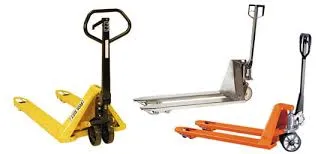


Exploring the Benefits of Full Electric Pallet Jacks
In the fast-paced world of logistics and warehousing, efficiency is paramount. One of the innovations that have significantly transformed material handling is the full electric pallet jack. This equipment not only enhances productivity but also improves safety and comfort for operators. This article explores the benefits of utilizing full electric pallet jacks in modern warehouses and distribution centers.
What is a Full Electric Pallet Jack?
A full electric pallet jack, often referred to as an electric pallet truck, is a powered version of the manual pallet jack. It is designed to lift and move palletized loads with minimal physical effort from the operator. The device includes features such as a powered lift, integrated controls for maneuvering, and sometimes even advanced technology like load sensors and automatic braking systems.
Enhanced Efficiency
One of the primary advantages of full electric pallet jacks is their ability to enhance efficiency in material handling operations. Unlike manual jacks, which require significant physical effort to lift and move loads, electric models enable operators to transport heavier loads over greater distances with ease. The electric motor allows for swift acceleration, smoother navigation, and faster load handling, resulting in reduced cycle times and increased throughput in warehouses. This efficiency is particularly crucial in environments where every second counts, such as during peak distribution periods.
Improved Safety
Safety is a critical concern in any warehouse environment. Full electric pallet jacks come equipped with various safety features that help minimize the risk of accidents and injuries. For instance, these jacks often have programmable speed limits, automatic braking systems, and ergonomic handles that reduce strain on the operator. Additionally, many models feature anti-rollback systems, which prevent the jack from rolling backward on inclines. By investing in electric pallet jacks, companies can create a safer working environment and reduce the likelihood of workplace injuries.

Operator Comfort and Reduced Fatigue
With the use of full electric pallet jacks, operators experience significantly less physical strain compared to manual pallet jacks. The ergonomic designs of electric models are tailored to provide optimal comfort for the user. This comfort is essential in reducing operator fatigue, especially in environments where employees may be required to perform repetitive lifting and transporting tasks for extended periods. By decreasing physical demands, companies can boost employee morale and productivity, as well as foster a healthier workplace culture.
Versatility and Adaptability
Full electric pallet jacks are versatile tools suitable for a variety of applications. Whether in grocery stores, warehouses, or manufacturing plants, these machines can adapt to moving different types of palletized loads. Some models can even navigate narrow aisles and tight spaces, making them an ideal choice for crowded warehouses. Their ability to easily maneuver in various environments enhances their overall utility and makes them a valuable investment for businesses.
Environmental Benefits
As businesses increasingly focus on sustainability, electric pallet jacks provide an eco-friendly alternative to traditional gas-powered equipment. They produce zero emissions during operation, which reduces the carbon footprint of the logistics process. Additionally, electric models often have lower operating costs, as they require less maintenance and have lower energy consumption compared to their combustion engine counterparts.
Conclusion
In conclusion, full electric pallet jacks are indispensable tools that bring numerous benefits to material handling operations. From enhancing efficiency and improving safety to reducing operator fatigue and offering versatility, these electric solutions prove to be a smart investment for businesses looking to streamline their operations. With their sustainable advantages, electric pallet jacks are not just an enhancement to logistics; they are a step toward a more productive and environmentally responsible future in warehousing and distribution.



